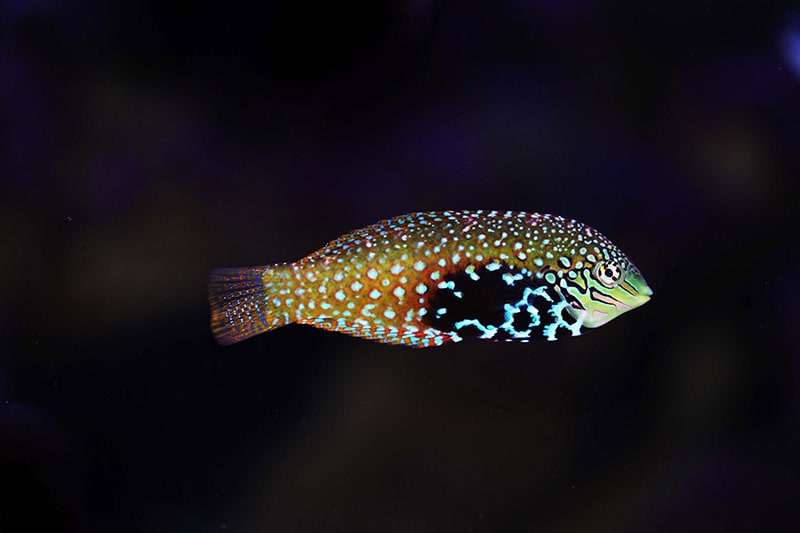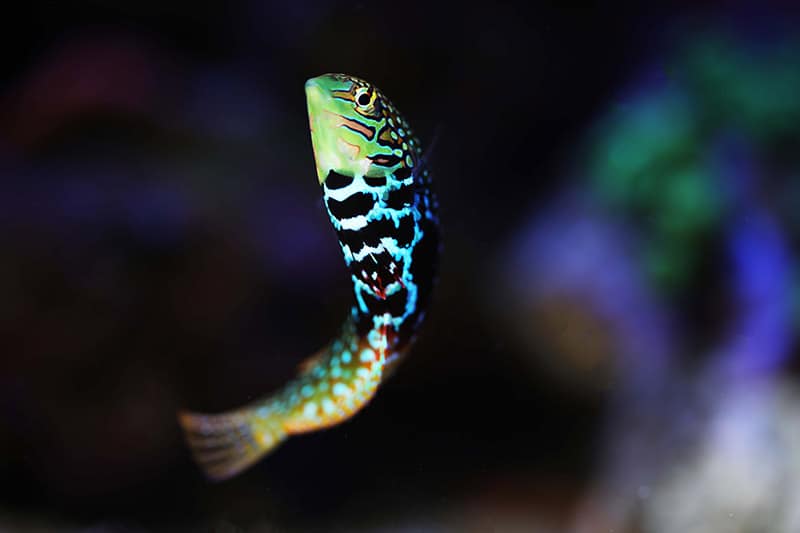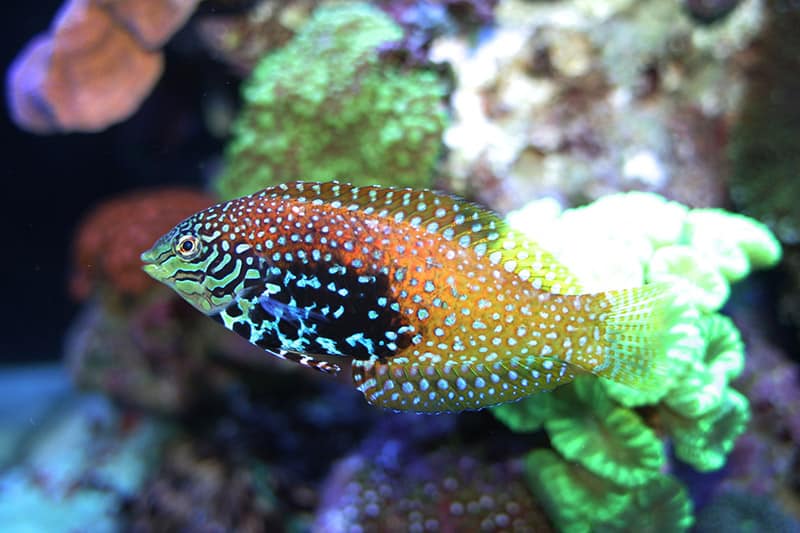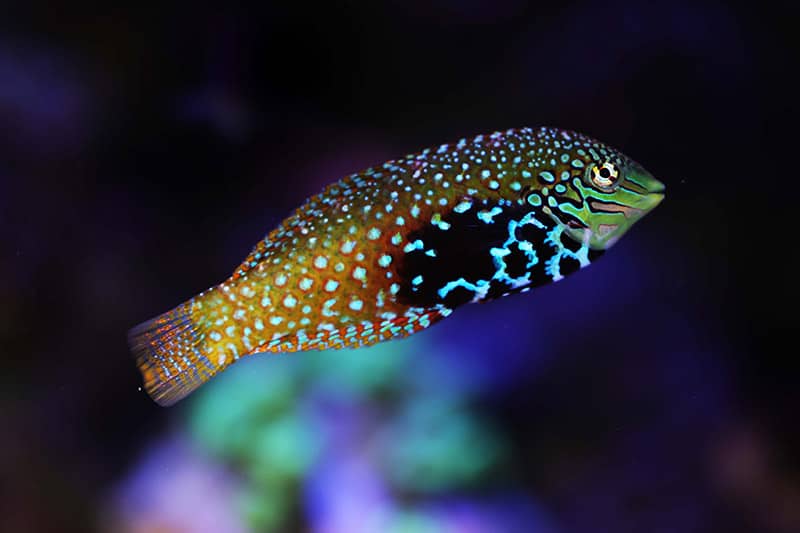With the spectacular colors on this fish and its distinctive spotted patterning…this fish is definitely a ‘splendid leopard’!
The Splendid Leopard Wrasse or Vermiculate Wrasse is very colorful and well suited to these two names. However it is referred to by a half a dozen other descriptive names as well including; African Leopard Wrasse, Peacock Splendid Wrasse, Blue Star Leopard Wrasse, and Divided Leopard Wrasse. These too describe the fish’s appearance, which changes from one beautiful color pattern as a female into another when becoming male. Pictured above is a juvenile or an adult female specimen, an adult male has a linear patterning on the body with a pretty bluish green coloration.
Once adjusted to aquarium life, the Splendid Leopard Wrasse or Vermiculate Wrasse is a wonderful peaceful community fish that can even be housed with others of the same genus. This is also one of the few wrasses that can be kept with its own species. In both cases however, they are harmonious as long the mix is all females with just one male.
Though they do not bother corals or other fish, the Splendid Leopard Wrasse is not a fish for the inexperienced. Like all the Leopard Wrasse, the genus Macropharyngodon, this wrasse can do quite well in a reef setting designed for them but they will fair poorly in all other types of marine environments. Due to their specialized eating habits and nature, these wrasses should only be attempted by advanced aquarists as they are very difficult to establish. They are not forgiving and can end up deceased in a short period of time after being added to your tank.
In his article Fish Tales: The Leopards of the Reef, author Henry C. Schultz III advises that these wrasses be examined before purchase (see Availability below) and that specialized care is followed to
acclimate and ultimately keep these fish successfully, (see Maintenance difficulty below). He also says
they tend to have intestinal worms and are prone to typical marine fish illness.
The Leopard Wrasses have a variety of curious behaviors. They are on Indo-Pacific time, so don’t freak if their sleeping habits are a little odd at first. Also as a protection in their natural habitat, they perform a little dance that is really strange to a possible predator. Often this dance antic works to the point the predator basically thinks the fish is nuts and moves on. If that tactic doesn’t work then the local sandbar will provide a perfect place for escape, and a puff of sand is the only indication the wrasse is “down under”.
Burrowing into the sand is their favorite sleeping arrangement. Some say you can set your watch by their bedtime! In the morning, they poke their head out to make sure the coast is clear and then they will fully emerge. When first emerging, they will be a little on the loopy side until they get their bearing, up to 10 minutes later. Throughout the day they are constantly foraging for food on live rock with their canine teeth.
- For more information on keeping this fish see: Guide to a Happy, Healthy Marine Aquarium
Scientific Classification
| Kingdom: | Animalia |
| Phylum: | Chordata |
| Class: | Actinopterygii |
| Order: | Perciformes |
| Family: | Labridae |
| Genus: | Macropharyngodon |
| Species: | bipartitus bipartitus |

Habitat: Natural geographic location
The Splendid Leopard Wrasse or Vermiculate Wrasse was described by Smith in 1957. They are found in the West Indian Ocean to the Maldives and the Red Sea, inhabiting lagoons and invertebrate rich clear reefs to depths of about 99 feet (30 meters). They are seen swimming singly or in a small group of females and juveniles with one dominant male. The sandy bottom is the preferred resting place for the night and the preferred hiding place during the day when threatened.
There are two subspecies:
- Macropharyngodon bipartitus bipartitus
- Macropharyngodon bipartitus marisrubri
The nominant species, Macropharyngodon b. bipartitus, is the most often seen wrasse. The other subspecies Macropharyngodon b. marisrubri is from the Red Sea, specifically from the Gulf of Aqaba, and it differs somewhat from the nominate species. Its color pattern is slightly different and it is also reportedly smaller, with adults reaching up to only about 3.7 inches (9.5 cm).
Status
These fish are not listed on the IUCN Red List.
Description
Juveniles and females have white spots all over. Their bodies have a black stomach area with a reddish color on the top half or next to the stomach. The fins on both the top and bottom, the tail, and the top of the body are yellow. Males develops a blue linear patterning on the body and have a bluish green coloration.
Leopard Wrasses have been known to live from 5 to 8 years in captivity.
Length/Diameter of fish
Splendid Leopard Wrasse adults can grow to 5 inches (13 cm).

Maintenance difficulty:
Due to their specialized eating habits and nature, Splendid Leopard Wrasses should only be attempted by advanced aquarists as they are very difficult to keep. The key to successfully keeping this wrasse is ultimately a well established reef tank, with lots of food (micro-crustaceans) flourishing in the environment. Do not put with other fish that will compete for food. Also, they tend not to tolerate copper.
Some guidelines for establishing these fish:
- Before purchasing this wrasse, it is recommended that you have an established quarantine tank (about 3 months is suggested). It needs to have live rock supporting micro-crustaceans such as copepods, and a 3″ sand bed.
- The quarantine period needs to be about 4 to 6 weeks.
- They must be treated for worms, because as many as 75 to 85% of these wrasses arrive with intestinal worms. Treat with 250 mg (.0089 ounces) of Piperazine, praziquantel, or levamisole per 100g of food (3.5 ounces) each day for 10 days. Another option is niclosamide at 500 mg (.0176 ounces) per 100g of food (3.5 ounces) for 10 days. You may have to gut load live foods to administer the medication.
- During this quarantine period, you can train the wrasse into accepting prepared foods.
- After the quarantine period transfer the wrasse to its new aquarium. Do this at night using a couple nets to capture the wrasse. Do not use a a container for capturing as you do not want your just awoken wrasse darting into the sides and damaging it’s mouth. It will be under the sand and generally they pick one favorite spot. Use one net to probe on one side of his spot and the other to catch the fish as It dashes out, away from the probing net in panic.
- Once netted, transfer it to the main aquarium. If the two aquariums are not the same temperature, you may need to temperature acclimate the wrasse first. To do this, deposit the fish into a container or plastic bag. Float the container in the main aquarium for about 10 to 15 minutes, then release the wrasse into the aquarium.
- The fish will dart straight down into the sand bed and may not be seen for several days.
Foods
The Splendid Leopard Wrasses are carnivorous. In the wild they mostly eat small invertebrates such as foraminiferans (small shelled protozoa) and snails, which they pick from the reef with their canine teeth, then use their pharyngeal teeth to pulverize. They also eat small amounts of copepods and amphipods.
Provide your new wrasse with live foods such as feeder shrimp and live black worms. Slowly introduce them to mussel meat, mysis, krill and plankton. Feed several times a day. Try to gut load the live foods with vitamin preparations for marine fish, and soak prepared foods in the vitamins. Providing a constant source of natural prey through a productive refugium will also help.
Maintenance
Normal water changes at 10% biweekly or 20% monthly. During quarantine period, use the main tank water for water changes into the quarantine tank.
For more information see, Marine Aquarium Basics: Maintenance
Aquarium Parameters
This fish needs to have lots live rock producing its natural habitat foods (micro-crustaceans) to ensure an easy transition to captive life. A minimum 2″ sand bed is imperative, and more is even better. Using a tight fitting lid lid is a good idea as they may jump if semi-aggressive fish are in the tank.
Minimum Tank Length/Size:
A minimum 50 gallon (189 liters) aquarium.
Light: Recommended light levels
No special requirements.
Temperature:
No special requirements. Normal temperatures for marine fish is between 74° and 79° Fahrenheit.
Water Movement: Weak, Moderate, Strong
No special requirements.
Water Region: Top, Middle, Bottom
They will spending in all parts of the aquarium.

Social Behaviors
The Splendid Leopard Wrasse or Vermiculate Wrasse is best in pairs or groups, though the tank must be larger to sustain more than one. It is one of the few wrasses that may be kept with their own genus (Macropharyngodon), and then only if one is fish male and the rest are female.
They are reef safe, though the do eat tiny micro-crustaceans, they will not bother the corals. Compatible with all peaceful fish and some semi-aggressive fish like dottybacks, dwarf angels, jawfish, rabbitfish and the like. If semi-aggressive fish are in the plans, add the leopard wrasse first. Do not put with Puffers, scorpionfish, groupers or other fish large enough to eat them. Also avoid slow, methodical feeders such as seahorses or pipefish.
Sexual differences
All are born female and change as the need arises. The spots on a male Splendid Leopard Wrasse change radically into vertical striping on the front half to two thirds of the body, turning into vertical blotches through the caudal peduncle. It has a bluish body color with the striping being an aquamarine to a dark blue. Interestingly, once this wrasse turns into a male, the change cannot be reversed.
Breeding/Reproduction
They have not been bred in captivity.
Availability
The Splendid Leopard Wrasse or Vermiculate Wrasse is occasionally available. They are sometimes available on the internet or as a special ordered through a pet store.
When special ordering, request 2″ of sand for shipment and make sure you see the fish come out of the box with the sand in the bag. Put down a deposit and observe the fish for a few days before purchasing.
Some things to check for when obtaining these fish:
- How does the fish swim? If it is swimming aimlessly in circles its chance of survival is slim. Also, avoid any fish pacing in front of the dealers tank. The fish should be foraging, constantly and methodically examining each piece of live rock for food.
- How is the mouth and body? Due to the desire of this fish to dive into the sand when scared, the shipping bag should have 2″ of sand. This will help minimize mouth damage from the fish diving. Examine the mouth for any abrasions or cuts or any damage at all. Excessive damaged mouth can prevent the poor fish from eating and possibly lead to starvation. Check the body for any ulcers, cuts, etc.
- Does it eat when fed? Have the dealer feed the fish, preferably with live mysis or black worms. More than likely it will not eat frozen food as of yet, due to its eating habits in the wild. If the fish eats the live food, and especially if it eats frozen, then take it home. If not eating, this doesn’t mean to necessarily rule it out, it may be a result of the having just arrived. They often won’t eat for up to a week after shipping.
For success in keeping this wrasse, follow the methodical procedure described in Maintenance difficulty above.
- Beginner Fish – Saltwater fish for beginners
- Community Fish – Peaceful Saltwater fish
- Hardy Fish – Hardy Saltwater fish
Featured Image Credit: Pavaphon Supanantananont, Shutterstock
